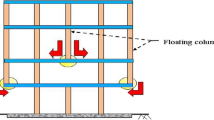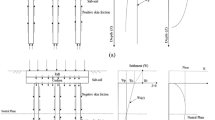Abstract
The performance of scrap tyre rubber pads (STRP) fabricated by used automobile tyres as seismic shock absorbers is evaluated in this study. STRPs are extremely good in low-rise buildings, even in places with high seismic risk, and are cost-efficient in developing countries. The SAP 2000 software package was used to study four-storey normal buildings of one type and irregularly shaped buildings such as plan irregularity (H shape, square core type, and plus type) and vertical geometry irregularity (two types) of fixed and STRP base. The study is carried out using the Fast Nonlinear Analysis (Nonlinear Modal Time History Analysis) approach. This procedure yields real and accurate outcomes in a shorter amount of time. The STRPs, for example, are developed utilizing UBC-97 design principles that are relevant for Indian circumstances. The six different real-time-history records selected based on peak ground accelerations are examined for convergence using SeismoMatch software. Most importantly, IS code matching is accomplished for all soil conditions. The dynamic parameters of the buildings were determined and discussed, including base shear, acceleration, storey displacement, storey drift, storey drift ratio, and hysteresis loops with respect to magnitude and Peak ground acceleration (PGA). The analysis demonstrates that the base shear reduction is prominent in EQ1 (PGA-0.876 g) and EQ5 (0.534 g) for plan irregularity type buildings compared to regular type and vertical irregularity type buildings. Furthermore, maximum acceleration reduction is achieved in regular type buildings compared to other buildings with STRP base of about 30–40% during EQ1 (PGA-0.876 g) and EQ5 (0.534 g). Subsequently, storey displacement and drift responses are significant in vertical geometry irregular buildings compared to plan irregular type and regular one. Therefore, it is translucent from the investigation is that the seismic responses of the buildings are predominantly influenced by the structural elements and the intensity/PGA of the seismic events irrespective of its irregularity profile.









Similar content being viewed by others
References
American Society of Civil Engineers. (2006). Minimum design loads for buildings and other structures. ASCE Standard ASCE/SEI 7-05.
Bandopadhyaya S., Sengupta A., & Reddy G. R. (2013). Experimental investigation into natural base isolation system for earthquake protection. In: 7th International Conference on Case Histories on Geotechnical Engineering, Missouri University of Science and Technology, Chicago, 2013. Paper.No.4.10 b. Retrieved from https://scholarsmine.mst.edu/cgi/viewcontent.cgi?article=3194&context=icchge.
Bhandari, M., Bharti, S. D., Shrimali, M. K., & Datta, T. K. (2017). The numerical study of base-isolated buildings under near-field and far-field earthquakes. Journal of Earthquake Engineering., 22(6), 989–1007.
Bhandari, M., Bharti, S. D., Shrimali, M. K., & Datta, T. K. (2019). Seismic fragility analysis of base-isolated building frame excited by near and far field earthquakes, recent. Advances in Structural Engineering, 1, 1025–1036.
Braga, F., Manfredi, V., Masi, A., Salvatori, A., & Vona, M. (2011). Performance of non-structural elements in RC buildings during the L’Aquila 2009 earthquake. Bulletin of Earthquake Engineering, 9(1), 307–324.
Buckle, I. G., Mayes, R. L., & Eeri, M. (1990). Seismic isolation: History, application and performance—a world view. Earthquake Spectra, 6(2), 161–201.
Causevic, M., & Mitrovic, S. (2020). Comparison between nonlinear dynamic and static seismic analysis of structures according to European and US provisions. Bulletin of Earthquake Engineering, 9(2), 467–489.
Chanda, A., & Debbarma, R. (2022). Probabilistic seismic analysis of base isolated buildings considering near and far field earthquake ground motions. Structure and Infrastructure Engineering, 18(1), 97–108.
Cici Jennifer Raj, J., & Suppiah, S. (2021). Seismic isolation using scrap tire rubber pads. Materials Today Proceedings, 43(2), 1404–1407.
Cici Jennifer Raj, J., & Vinod Kumar, M. (2021). Influence at mass of the base isolation system in affecting the higher modes of vibration. Turkish Journal of Computer and Mathematics Education, 12(2), 1809–1815.
Cici Jennifer Raj, J., & Vinod Kumar, M. (2022). Seismic protection with different isolation materials. Indian Journal of Environmental Protection, 1(42), 71–79.
COSMOS. (1997). Strong-motion virtual data centre. Consort Organ Strong Motion Obs Syst 1997. Retrieved from https://www.strongmotioncenter.org/vdc/scripts/earthquakes.plx.
De Luca, A., & Guidi, L. G. (2019). State of art in the worldwide evolution of base isolation design. Soil Dynamics and Earthquake Engineering, 125, 105722.
Dutta, S. C., Das, P. K., & Sengupta, P. (2017). Seismic behavior of irregular structures. Structural Engineering International, 27(4), 526–545.
Hassan, A., & Pal, S. (2018). Effect of soil condition on seismic response of isolated base buildings. International Journal of Advanced Structural Engineering, 10, 249–261.
IS 1893. (2016). Indian standard criteria for earthquake resistant design of structures. New Delhi: Bureau of Indian Standards.
Jie, S. W., Tong, Y. S., Kasa, A., & Osman, S. A. (2016). Effect of recycle tire isolator as earthquake resistance system for low rise buildings in Malaysia. Journal of Engineering Science and Technology, 11(8), 1207–1220.
Kelly, T. (2001). Base isolation of structures, design guidelines. Holmes Consulting Group ltd.
Khanal, B., & Chaulagain, H. (2020). Seismic elastic performance of L-shaped building frames through plan irregularities. Structures, 27, 22–30.
Khose, V., Singh, Y., & Lang, D. (2010). Limitations of indian seismic design codes for RC buildings. In: 14th Symposium on Earthquake Engineering, Department of Earthquake Engineering, Indian Institute of Technology, Roorkee, December 17–19, 2010.
Lai, L., Takeuchi, K., Tomono, Y., & Okimoto, Y. (2014). Overview of T-bags base isolation method for building foundation. Takeuchi Construction.
Lancieri, M., & Bazzurro, P. (2018). Spectral matching in time domain: A seismological and engineering analysis. Bulletin of the Seismological Society of America, 4(108), 1972–1994.
Losanno, D., Calabrese, A., Madera-Sierra, I. E., Spizzuoco, M., Marulanda, J., Thomson, P., & Serino, G. (2020). Recycled versus natural-rubber fiber-reinforced bearings for base isolation: Review of the experimental findings. Journal of Earthquake Engineering, 26(4), 1921–1940.
Madhekar, N. S., & Vairagadi, H. (2019). Innovative base isolators from scrap tyre rubber pads. In: Proceedings of Ukieri Concrete Congress, 2019, pp. 1–15. Retrieved from https://ukiericoncretecongress.com.
Mazza, F. (2019). Effects of the long-term behavior of isolation devices on the seismic response of base-isolated buildings. Structural Control and Health Monitoring, 26(4), 2331.
Mazza, F. (2021). Base-isolation of a hospital pavilion against in-plane-out-of-plane seismic collapse of masonry infills. Engineering Structures, 228, 111504.
McVitty W.J., & Constantinou M. C. (2015). Property modification factors for seismic isolators: design guidance for buildings. MCEER Report NO. 15–0005.
Mohamed, O. H., & Abdelhafid, O. (2013). Parameters influencing response of a base isolated building. Asian Journal of Civil Engineering, 15(2), 259–275.
Mohod, M. V. (2015). Effect of shape and plan configuration on seismic response of structure. International Journal of Scientific & Technology Research, 4(09), 84–88.
Muniz, A., Diaz, M., & Reyna, R. (2019). Applicability study of a low- cost seismic isolator prototype using recycled rubber. Journal Tecnia, 2(29), 65–73.
Naeim, F., Bhatia, H., & Lobo, R. M. (2001). Performance Based Seismic Engineering. In: Naeim F. (Ed.), The Seismic Design Handbook (pp. 752–792). Boston, MA: Springer.
Nagarajaiah, S., Reinhorn, A., & Constantinou, M. (1993). Torsion in base-isolated structures with elastomeric isolation systems. Journal of Structural Engineering-ASCE, 119(10), 2932–2951.
National Institute of Standards and Technology. (2011). Selecting and Scaling Earthquake Ground Motions for Performing Response-History Analyses. NIST GCR 11-917-15. Prepared by the NEHRP Consultants Joint Venture for NIST, Gaithersburg, Maryland, 2011.
Pacific Earthquake Engineering Research Centre (PEER). (2015). Open systems for earthquake engineering simulation (Open Sees), version 2.4.6. PEER, University of California.
Paret, T. F., Rosenboom, O., A., Rautenberg, J. M., & Searer, G.R. (2012). Calibration of various nonlinear analysis procedures with earthquake damage in a reinforced concrete shear wall building. In: 15th World Conference on Earthquake Engineering, Lisbon, Portugal, 2012; vol. 12, pp. 9194–9202.
Prasad, J. S. R., Singh, Y., Kaynia, A. M., & Lindholm, C. (2009). Socioeconomic clustering in seismic risk assessment of urban housing stock. Earthquake Spectra, 25(3), 619–641.
Reyes, J. C., Kalkan, E., & Sierra, A. (2017). Fast nonlinear response time history analysis. In: 16th World Conference on Earthquake, Santiago Chile, January 9th to 13th 2017; pp.1–11 (Paper.No. 1673).
Saevfors, I. (2011). Used Tire as Base Isolator Tire for Earthquake Resistant Houses’. Journal of Rekayasa Sipil Architect of Saevfor Consulting, Sweden, 7, 37–44.
SAP 2000. (2021). Analysis reference. Computers and Structures, Inc CSI.
SeismoMatch. (2021). A computer program for spectrum matching of earthquake records
Shirai, K., & Park, J. (2020). Use of scrap tire pads in vibration control system for seismic response reduction of buildings. Bulletin of Earthquake Engineering, 18, 2497–2521.
Sil, A., & Sitharam, T. (2015). Site specific design response spectrum proposed for the capital city of Agartala, Tripura, Geomatics. Natural Hazards and Risk, 7(5), 1610–1630.
Soleimanloo, H. S. (2012). A survey study on design procedure of seismic base isolation systems. Journal of Applied Sciences and Environmental Management, 16(4), 299–307.
Somwanshi, M. A., & Pantawane, R. N. (2015). Seismic analysis of fixed based and base isolated building structures. International Journal of Multidisciplinary and Current Research, 3, 747–757.
Subramanian, K., & Velayutham, M. (2012). Influence of seismic zone factor and the international codal provisions for various lateral load resisting systems in multi storey buildings. Indian Society of Earthquake Technology.
Tanwar, M., Kazi, T., & Desai, M. (2018). A study on different types of base isolation system over fixed based. Information and Communication Technology for Intelligent Systems, 106, 725–734.
Tsang, H. H., Sheikh, M. N., & Lam, N. (2007). Rubber soil cushion for earthquake protection. In: Australia Earthquake Engineering Society Conference, Australia, 2007, pp. 1–7.
Turer, A., & Ozden, B. (2008). Seismic Base Isolation using low–cost scrap tyre Pads (STP). Materials and Structures, 41, 891–908.
Uniform Building Code (UBC-97). (1997). Earthquake regulations for seismic isolated structures (Vol. 2). Uniform Building Code.
Acknowledgements
I would like to express my gratitude to Dr. M. Vinod Kumar, Associate Professor Vel Tech Rangarajan Dr. Sagunthala R&D Institute of Science and Technology, for his valuable assistance and advice during the study. I also want to thank Vel Tech Rangarajan Dr. Sagunthala R&D Institute of Science and Technology, University, for enabling me to do my research.
Funding
The authors have not disclosed any funding.
Author information
Authors and Affiliations
Corresponding author
Ethics declarations
Competing interest
There is no conflict of interest.
Additional information
Publisher's Note
Springer Nature remains neutral with regard to jurisdictional claims in published maps and institutional affiliations.
Rights and permissions
About this article
Cite this article
Raj, J.C.J., Kumar, M.V. Seismic response of low-to-high peak ground acceleration earthquakes in RC framed buildings with scrap tyre as base isolator using fast nonlinear analysis technique. Asian J Civ Eng 23, 425–441 (2022). https://doi.org/10.1007/s42107-022-00434-y
Received:
Accepted:
Published:
Issue Date:
DOI: https://doi.org/10.1007/s42107-022-00434-y




